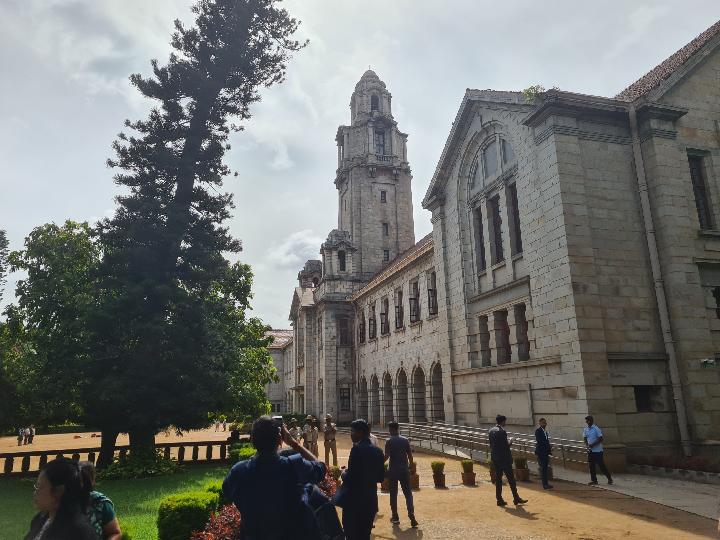By Petir Garda Bhwana
Copyright tempo

TEMPO.CO, Bangalore, India – The Indian Institute of Science (IISc), located in Bangalore, India, is one of the country’s most prestigious academic and research institutions. It showcased its legacy, innovation, and growing international partnerships during an interactive session with visiting journalists from Southeast Asia, including Tempo from Indonesia, on Monday, September 29, 2025.The delegation was welcomed by Dr. Abhishek Singh, Professor and faculty member at the Materials Research Centre and core committee member of the Office of International Relations. Representing the institute’s chair, Professor Ram Ray, Dr. Singh extended greetings to the media representatives from Malaysia, Indonesia, Myanmar, Singapore, Thailand, Laos, Vietnam, Cambodia, and Timor Leste. He described the visit as an opportunity to “build strong collaborations” between IISc and universities in the Global South.Abhishek Singh, (first from the right) Professor of Materials Research Centre at Indian Institute of Science (IISc) Bangalore, is explaining the works of the institute during the Familiarization Visit of Journalists to India, September 29, 2025. Mediacorp Pte Ltd/Mogana Nair IISc Brief BackgroundFounded in 1909 by industrialist Jamsetji Nusserwanji Tata with support from the Mysore royal family, IISc was envisioned to promote “original investigation in all branches of learning” for the benefit of India. The 440-acre campus continues to serve as a hub for cutting-edge research and innovation, supported by the Government of India’s Ministry of Education. IISc has consistently ranked number one in the National Institutional Ranking Framework (NIRF) since its inception in 2016, and its departments in Data Science and Artificial Intelligence are globally ranked within the top 50.Dr. Singh highlighted that IISc remains primarily a postgraduate research university, with more than 5,500 students, including 3,000 pursuing PhDs. “We publish close to 3,000 papers every year and have over 500 faculty members,” he said. “Our research is widely read and cited across the world, which is a testament to the quality of work produced here.” The institute’s healthy student-to-faculty ratio of 10:1, he added, ensures personalized mentorship and research excellence.The presentation outlined IISc’s legacy as the alma mater of many nation-builders, including Dr. Vikram Sarabhai and Dr. Satish Dhawan, architects of India’s space program. The tradition continues today, with IISc providing academic training to astronauts preparing for India’s first manned space mission. “They pursued their Master’s degrees here, focusing on advanced space sciences,” Dr. Singh said, noting that the institute’s contribution to the Indian space program remains deeply rooted in its ethos of scientific service.The Divisions and FacilitiesOver the decades, IISc has expanded into seven divisions, including biological, chemical, physical and mathematical, mechanical, electrical and computer, interdisciplinary, and medical sciences. “Our new medical sciences division and upcoming 842-bed specialty hospital are designed to merge engineering and clinical research to train the next generation of doctors,” Dr. Singh said. “The hospital will begin operations with 500 beds and a strong research foundation.”Among IISc’s most advanced facilities are India’s first NanoFab, a 3.3-petaflop supercomputer, and a BSL-3 laboratory for infectious disease research — one of the few in the world. “Our NanoFab facility not only serves Indian researchers but also welcomes scientists from neighboring countries for training,” he said, emphasizing IISc’s role as a regional leader in scientific collaboration.Dr. Singh also discussed major research initiatives, including the Artificial Intelligence and Robotics Technology Park (ARTPARK), which supports projects like Bhasha Shethu, aimed at bridging India’s 22 official languages through language models. “We’re also leading in quantum technologies,” he said, explaining that IISc offers India’s first academic program in quantum science and works closely with industry and international partners.Eyeing Southeast Asian StudentsSingh encouraged visiting journalists to promote academic exchanges between IISc and institutions in Southeast Asia, emphasizing programs that support student and faculty exchanges, joint PhD supervision, and collaborative research. “Our programs are fully funded,” he said. “We welcome international students, researchers, and faculty to come and spend time with us — they receive travel support, accommodation, and full funding for their stay.”He emphasized that admissions are still quite competitive even though IISc welcomed applications from all across the world.“Students are welcome to apply for any of our programs,” said Singh. “But we have a very strict screening process. If you can meet the criteria, you’re in.”During the Q&A session, journalists raised questions about rare earth research, gender representation in science, and global university rankings. Dr. Singh explained that India is exploring two main approaches to the rare earth challenge — recovery and recycling of existing materials and the development of earth-abundant alternatives. On gender equality, he said the institute has “no discrimination whatsoever” and highlighted the cultural progressiveness of southern India, where IISc is located.Addressing a question about university rankings compared to peers in China and Singapore, Dr. Singh acknowledged the competition but noted that IISc’s autonomy and focus on high-impact research were its key strengths. “We continuously evolve our curriculum and collaborate globally,” he said. “What makes us proud is that our work is not just about rankings — it’s about making science meaningful for society.”Editor’s Choice: India Strengthens Maritime Security Network in the Indian Ocean RegionClick here to get the latest news updates from Tempo on Google News